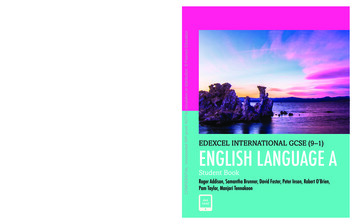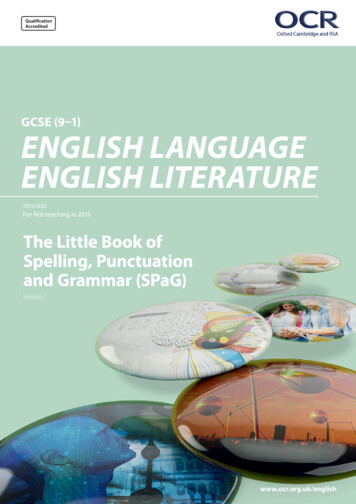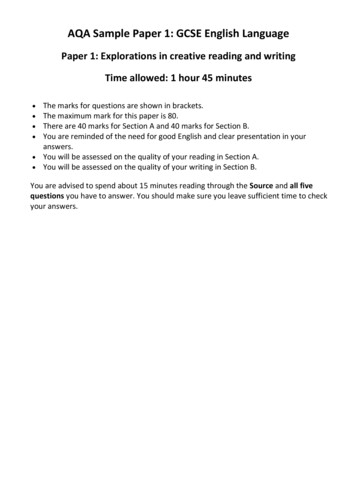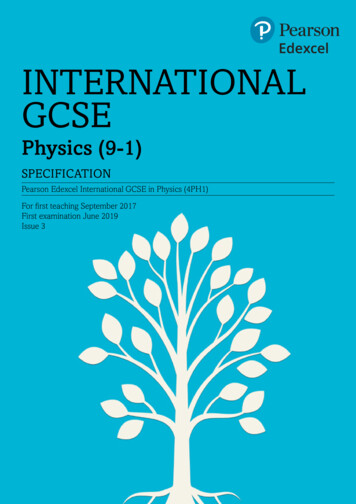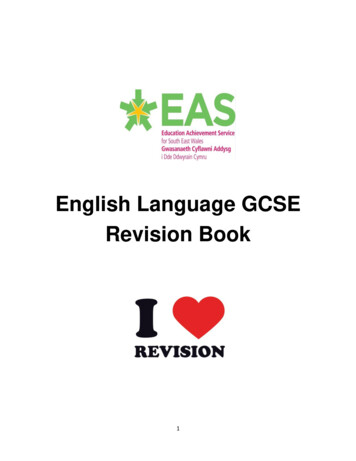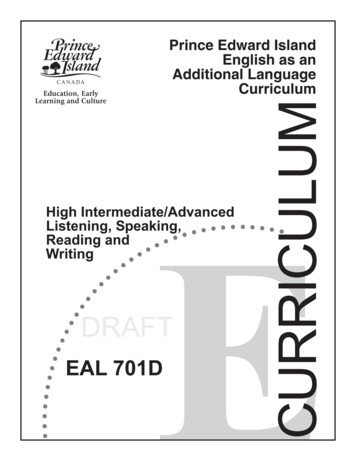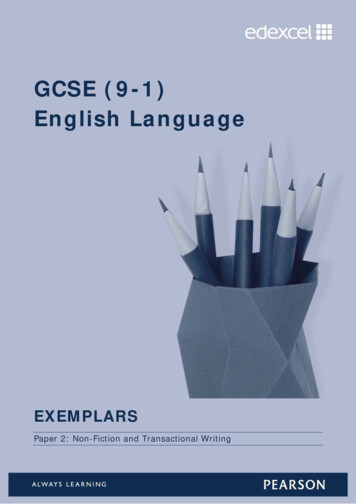
Transcription
GCSE (9-1)English LanguageEXEMPLARSPaper 2: Non-Fiction and Transactional Writing
GCSE Language 2015Student exemplar responses forPaper 2: Non-Fiction and TransactionalWritingContentsIntroductionPaper 2: Section A – stionQuestion12345671224613151725Paper 2: Section B – Transactional WritingQuestion 8Question 9363645 Pearson Education Limited 2015
IntroductionThis pack has been produced to support GCSE English Language teachersdelivering the new GCSE English Language course in 2015 (first certificationsummer 2017).The pack contains exemplar student responses to GCSE English Language Paper2 (Section A – Non-Fiction Reading and Section B – Transactional Writing). Itshows real student responses to the questions taken from the sampleassessment materials. In some cases, the original student responses have beenadapted by the marker to provide clearer exemplification of the mark scheme.There are also exemplars for GCSE English Language Paper 1 and GCSE EnglishLiterature available to download from our websiteSection A questions address four Reading Assessment Objectives: AO1, AO2,AO3 and AO4.Reading – 50%AO1 Identify and interpret explicit and implicit information and ideas Select and synthesise evidence from different textsAO2Explain, comment on and analyse how writers use language and structureto achieve effects and influence readers, using relevant subjectterminology to support their viewsAO3Compare writers’ ideas and perspectives, as well as how these areconveyed, across two or more textsAO4Evaluate texts critically and support this with appropriate textualreferencesSection B questions address two writing Assessment Objectives: AO5 and AO6.Writing – 50%AO5AO6 Communicate clearly, effectively and imaginatively, selecting andadapting tone, style and register for different forms, purposes andaudiences. Organise information and ideas, using structural and grammaticalfeatures to support coherence and cohesion of texts.Candidates must use a range of vocabulary and sentence structures forclarity, purpose and effect, with accurate spelling and punctuation.Following each question you will find the mark scheme for the band that thestudent has achieved, with accompanying marker comments on how the markshave been awarded, and any ways in which the response might have beenimproved.1
Paper 2: Section A – ReadingQuestion 1Candidate A1. They must be British2. They must also hold a 2:2 degree or aboveMarker comment and markTwo correct answers offered.2 marksCandidate B1. Motivated problem solvers who do not crave the limelight2. People who are good at building relationshipsMarker comment and markTwo correct answers offered.2 marksCandidate C1. You must have a 2:2 degree or above2. AssessmentMarker comment and markThe first answer is correct but the second is not credited – it is what people needto do rather than have.1 mark2
Candidate D1. Online application2. Assessment courseMarker comment and markBoth answers are incorrect as they look at what people need to do rather thanhave.0 marksCandidate E1. Have to apply online2. Must be British and hold a 2:2 degree or above.Marker comment and markWhile the first answer is incorrect, two correct answers are given in the secondpart.2 marksMark schemeQuestionNumber1(AO1) AnswerMarkAccept any reasonable answer based on lines 22 to 30, up to amaximum of 2 marks.Quotations and candidate’s own words are acceptable.For example: 'motivated problem–solvers' (1) 'do not crave the limelight' (1) good at building relationships (1) willing to put themselves in danger (1) determined because it is hard to apply (1) British (1) have a degree at 2:2 or above. (1)(2)3
Question 2Candidate AThe writer uses comparatives 'wider than the cloisters of Oxbridge.'He also uses phrases that don't mean what they actually are. 'Notjust bluestockings.'Marker comment and markThis response achieves 1 mark. While the first example identified is relevant tohow the recruitment process has changed, it is not explained with reference tothe question. The second comment is not relevant to the question.1 markCandidate B‘There is a demand for more women, too'. The writer is putting theexaggeration on women implying that MI6's recruiting haschanged on the amount of women they let in.Marker comment and markThis response achieves 2 marks. The example is relevant for 1 mark and isexplained in terms of the recruitment process for the second mark.2 marks4
Candidate CThe writer uses 'cloisters' to describe Oxbridge. The word seems veryinformal, which means that he wants come across easy to thereader. It is also used in lines 15–18, which creates good humourfor the reader.Marker comment and markThis response comments on language but does not answer the question abouthow the recruitment process has changed. The answer achieves 0 marks.0 marksMark schemeQuestionNumber2(AO1) AnswerMarkAward 1 mark for a valid example from lines 1 to 8, and 1 markfor the text reference.Do NOT accept an example without a text reference.For example: the phrase 'tiptoed into the modern world' (1)shows it has taken a long time to change and itwas old fashioned before (1) saying 'it has had to' (1) shows that SIS has beenforced to change the way it recruits (1) the word 'wider' (1) shows that it is looking for abroad range of people (1) the mention of 'ethnic minorities' and 'women' (1)shows the broader types of people being recruited(1).(2)5
Question 3Candidate AIn the text the writer has taken a very formal approach. Forexample 'If the encounter proved satisfactory, the candidatereceived a letter inviting him to an interview'. The wordencounter comes across as posh as it's Standard English and givesgood imagery for the reader.Marker comment and markThis answer offers one key point about language which is the use of formallanguage, with an example used. This is only a comment, and describes thelanguage rather than analyses it. There is reference to some language 'comesacross as posh' and 'gives good imagery for the reader' which is broadly relatedto language. There is no comment on structure.Level 1 – 2 marksCandidate BThe writer uses language and structure to interest and engagereaders by using alliteration 'Subtle, stylish business'. This engagesthe reader by making MI6 sound interesting and exciting.Another way the writer uses language and structure to engage thereader is by using formal language. 'Managed to conceal hisclandestine life'. Using formal language was appropriate for thetopic and interested the reader by appealing to the targetaudience that might read about 'Britain's foreign intelligenceservice'.One way that the writer uses language to engage the reader isdescriptive language. 'Tall, elegant, forties, patrician.' Thisengaged the reader by describing what it was like to be in MI6.This helped the reader to visualise what it was like to be there andmade the article more interesting.The writer uses quotes in the text to engage the reader 'Work youcan believe in, Colleagues you can trust. This shows the variety ofdifferent ideas that the people at MI6 have to share, and adds a6
selection of different perspectives to the article, which make itmore interesting.Marker comment and markThis answer offers comment on language - alliteration, formal language,descriptive language. These have valid reference and explanation - to appeal tothe audience, create interest and to connect reader to writer. On language, theresponse could achieve Level 3. However, the response does not comment onstructure and thus cannot progress beyond the top of Level 2.Level 2 – 6 marksCandidate CThe writer attempts to engage the reader by using descriptivelanguage, for example 'subtle, stylish business'. This implies thatthe writer wants to draw the reader in and make them interested.He also does this by using alliteration which would have beenused in this because the vocabulary is catchy so it is easilyremembered, therefore many people will become more interestedin his writing, and it will become more popular within society.When the writer uses phrases like 'work you can believe in,Colleagues you can trust' this makes the reader want that toreally happen so this would make them more engaged to the pieceof writing because it would be something that they like. It suggeststhat the writer is trying to imply that the reader is being listenedto, the work being increased, and they are treated better, andcolleagues you can confide in if need be.The writer also uses language so it is structured out extremelywell, flowing fluently through each point he makes using speechcontrasted with prose. He used a creative technique to open thepiece 'Psst! Want to join MI6?' this implies that he is using a form ofdirect address towards the reader, so that he can instantlyengage them, therefore they wouldn't just turn past it straightaway, they would want to keep reading.Because of the structure the writer has chosen, once the reader hasstarted reading this piece of writing, they are instantly engaged,without a doubt, this would be because of the wording chosen. Atthe beginning of the text 'Psst' implies that he is whispering to thereader, and that he is sharing a secret with them as if no-one elseis allowed to hear the conversation. Many adjectives are used, forexample 'subtle, stylish', 'promising', 'curious', 'softly-spoken' which7
creates a more descriptive piece adding to the flavour of the text,and verbs are used to show action, e.g. 'recruiting', 'venturing','joining'.Marker comment and markThis answer offers comment on both language and structure, although thecomment on structure is vague and non-specific. The language points haveexplanation and include focus on vocabulary and use of sentence structure. Acouple of points are nearly explored, e.g. the secretive language, but not quiteenough for Level 4. There is enough explanation of language to achieve midLevel 3, but not enough on structure to meet the top of that level.Level 3 - 8 marksCandidate DThere are many ways that the writer engages the reader, at thebeginning of the text the writer uses a rhetorical question 'Want tojoin MI6?' this directly addresses the reader which engages thereader, as well as creating a sense that this text will not be totallyformal and will be more relaxed. The use of 'Psst!' creates aninformal tone which could suggest that spies don't have to be wellspoken 40 year olds, but normal people (as long as you have adegree) which relaxes the tone. It also uses humour to interest thereader 'the potential recruit (right school, right family) would besubjected to gentle interrogation over crumpets'. This engages thereader as it turns their attention directly to the text as theprobably wouldn't expect humour to be in the article about MI6,the whole text seems to be slightly informal (use of humour etc),which could link to their audience, young graduates. It also usesanecdotes (for example paragraph 5) to engage the reader as itincreases the informal tone, also anecdotes tend to be interesting!Paragraph 6 further uses anecdotes and rhetorical questions andhumour, 'What was it like being a spy? Could you tell your mum?'This addresses the reader and engages them and the humourcreates a light friendly tone which links to the target audiencewith abbreviations like 'mum'. The writer also uses slang'bluestockings' to interest the reader and link again to the targetaudience. It suggests that you don't have to be male to work forMI6 to a top Oxford graduate. The structure is set up to keep thereader interested, paragraphs 1-4 is the introduction and usesslang and humour to engage the reader and keeps the readermotivated, paragraphs 5-7 use anecdotes to heighten the reader's8
engagement and to create a sense of a grand finale, then thestructure finishes off with paragraphs 8-10 to include the lessinteresting recruitment procedures, creating maximumengagement of the readers at all times.Marker comment and markThis answer both explains and explores language features such as alliteration,anecdotes and rhetorical questions and consistently links back to the effect onreaders, although this is fairly repetitive. There is some sense of exploring howlanguage is linked to the text's potential readership, however. The explanationand exploration move the answer into Level 4. There is fairly broad explanationof structure in the development and set out of the text, although this is not asdetailed or specific as it is on language. Given this, the answer achieves themiddle of Level 4.Level 4 – 11 marksCandidate EThe writer has used varied sentence structure to keep the readerengaged. They have also included advanced and complexsentences with the use of colons and semi-colons which adds asophisticated aura to the text, this maximises the audience'sattention as it implies the writer knows exactly what they areportraying in the text.The reader's engagement is an obvious point of interest for thewriter. Throughout the text there is mockery of stereotypes'subjected to gentle interrogation over crumpets'. Crumpets areassociated as being typically British and considering MI6 isBritish it's an obvious link to attract a British audiences as well asto humour all ethnicities. Included in the text, the writer hasintertwined personal stories such as lines 20-27 with addeddiversity between candidates chosen so that it will appeal to allpersonalities and people in general - this makes the text seemsdiverse and subject to anyone this creates a light-hearted andrelatable atmosphere for the reader. 'Psst! Want to join MI6?' Thetitle is short, simple yet effective. The informal 'Psst!' at thebeginning really catches the reader's attention, as it is commonlyused before telling someone a secret. This links to the theme of thetext, spies, and adds a more 'once in a lifetime opportunity' feelwhich matches the concept of the text, working for MI6. The cleveruse of 'Psst!' is followed by a more intriguing literal device, arhetorical question 'Want to join MI6?' This gives direct address tothe reader which engages them. On top of that the meaning of the9
question relates to the reader because of the 'dream appeal' ofworking for MI6 - it makes it seem as if anyone could if theywanted to, and who hasn't thought of being a spy? This givesinterest and excitement to the reader as the idealistic pictureforms in their imagination of them turning into a spy and beinglike Bond. The secret nature of spies is also reflected with verbs like'tiptoed' and verbs which suggest adventure such as 'venturing'.Positive adjectives like 'promising', 'elegant', 'smart', 'attractive'make the business and the people you would work with soundgreat.The language throughout the text is formal, sophisticated yet witha hint of humour. Slang/informal language has been included inthis article about MI6's recruitment as a way to become more on alevel with the audience. MI6 is known to be a top secret agencyand only for the chosen which gives it a high status names whichimmediately discounts some audiences, but including morecommon language and not only standard English re-opens thedoor for them. The use of informal language also keeps the textcurrent. The writer has used informal language such as 'tiptoed'and 'cast its net' (which also uses personification to make theagency seem more human) to contend with the modernisation ofthe recruitment process. The organisation is made to seem morehuman and real which connects to the audience.Marker comment and markThis answer demonstrates analysis of language at Level 5 overall. Theexploration of structure at the start of the piece is evident but not developed orexemplified enough. The candidate shows some discriminating examples, forexample the subtle mockery of stereotypes in the language use, the use of the'dream appeal' language and the use of personification in the presentation ofMI6. Some exploration of the effect is a little general, e.g. to create a lighthearted atmosphere and ‘keeps the text current'. However, there is enoughanalysis and discriminating use of examples to achieve the middle of Level 5.More development of the analysis and more analysis of structure would push themark to the top.Level 5 - 14 marks10
Mark schemeQuestionNumber3Indicative contentReward responses that analyse how the article uses language and structure tointerest and engage readers.Responses may include the following points about the language of the text: the writer uses literary techniques such as personification tocreate interest in the reader. Referring to SIS as someone'tiptoeing' into the modern world, creates a sense that they wantto do it quietly and without fuss or that they are not sure about itthe colloquial tone helps to strengthen rapport with the reader,e.g. 'Could you tell your mum?'the use of humour is designed to interest the reader and engagethem in what is being said. It also helps to make SIS seem lesssecret and 'untouchable', e.g. 'the kind who know what to dowith scatter cushions', 'Could you tell your mum?'the quotations from the officers make the job sound ‘normal’ andso more appealing, with references to family 'I do get to drop mydaughter at nursery and pick her up' and skills many people havesuch as 'building relationships'the article contrasts the normal with the unusual – the referencesto family are contrasted with the references to exotic foreigntravel 'Africa and the Middle East'Responses may include the following points about the structure of the text 11the use of short sentences at the start sets a conversational toneas if the writer is talking to the reader and telling them a secretabout the types of people being recruited, e.g. 'That increasinglymeans people from the ethnic minorities.' and 'There is a demandfor more women, too.'the structure of the article is used to surprise the reader andmake them realise that their ideas about spies are incorrect, e.g.the opening part shows that the recruitment drive is unusual andthe second part, from line 19, shows that there are particularqualities and requirementsthe use of short sentences in the section on applicationemphasises how difficult it is, e.g. 'Five per cent of applicants failpersonal vetting'.the repetition of percentages and 'half' in lines 24-26 shows howhard it is to be selected and this contrasts with the idea of itbeing open and friendly.
LevelLevel 1Level 2Mark01–34–6(AO2) DescriptorNo rewardable material. Limited comment on the text. Identification of the language and/or structure used to achieveeffects and influence readers. The use of references is limited. Comment on the text. Comment on the language and/or structure used to achieveeffects and influence readers, including use of vocabulary. The selection of references is valid, but not developed.NB: The mark awarded cannot progress beyond the top ofLevel 2 if only language OR structure has been considered.Level 3Level 4Level 5127–910–1213–15 Explanation of the text. Explanation of how both language and structure are used toachieve effects and influence readers, including use of vocabularyand sentence structure. The selection of references is appropriate and relevant to thepoints being made. Exploration of the text. Exploration of how both language and structure are used toachieve effects and influence readers, including use of vocabulary,sentence structure and other language features. The selection of references is detailed, appropriate and fullysupports the points being made. Analysis of the text. Analysis of how both language and structure are used to achieveeffects and influence readers, including use of vocabulary,sentence structure and other language features. The selection of references is discriminating and clarifies thepoints being made.
Question 4Candidate AThreeMarker comment and markCorrect answer.1 markCandidate B80 PeopleMarker comment and markIncorrect answer.0 marksCandidate CHe decodes 3 letters/messagesMarker comment and markThe correct answer is identified - although just ‘3’ would have been enough.1 markCandidate D2Marker comment and markIncorrect answer.0 marks13
Mark schemeQuestionNumber4(AO1) AnswerMarkAccept the answer below for 1 mark: Three (messages)(1)14
Question 5Candidate Aan unbreakable codeMarker comment and markThis response achieves 0 marks as there is an example identified but noexplanation.0 marksCandidate BThe word 'unbreakable' was used to show that it was impossible todecode.Marker comment and markThis response achieves 1 mark - there is an example and explanation.1 markCandidate C‘and it seemed safe to assume that with millions of Guilders atstake the government-in-exile would use an unbreakable code'Marker comment and markThis response achieves 0 marks as there is an example identified but noexplanation.0 marksCandidate DIt was difficult 'fast forward three years and there is our man in acrumpled linen suit'.15
Marker comment and markThis response achieves 0 marks. The example given is not from the appropriatetext.0 marksCandidate EHe uses sophisticated language like 'permutation' to show howsophisticated and difficult his task was.Marker comment and markThis response achieves 0 marks as it is from line 9, not from lines 6–8.0 marksMark schemeQuestionNumber5(AO2) AnswerMarkAward 1 mark for a valid example made about lines 6 to 8.Do NOT accept an example without an explanation.For example: the repetition of ‘and’ emphasises how complex histask is (1) the word ‘unbreakable’ makes you think that he willnever be able to break the code (1) the long first sentence, followed by ‘And gotnowhere.’, makes it sound like he is trying to dosomething impossible (1) ‘millions of guilders’ makes his task seem harder ashis enemy has a lot at stake. (1)(1)16
Question 6Candidate AThe writer was fairly successful using this relationship 'with girls'.As it felt as it was a new topic, but was still feeding informationabout the topic in a new way. For example 'The first step was totake a frequency count of the individual letters.' Theinformation in the sentence was quite complex therefore notengaging all audiences. However the next sentence reengaged thereader. 'The girls, some of whom had come armed with theGerman dictionaries'. As the text came from a new point of view(the girls' view). Which stereotypically is very different to complexcode breaking. This gives the effect of a new interesting topic. Theuse of 'the girls' also gives the anecdote more effect as it gives thestruggle of a real human relationship between the male as anoutsider towards the females. This engages the reader by puttingstereotypically two very different topics into one.Marker comment and markThe requirement for AO4 is to evaluate the text. This answer is very brief given itis worth 15 marks, and the only parts credited are 'fairly successful' as it showsan assertion about the text with a textual reference and the comment on thestruggle of the male/female relationship. Other than that some parts of theresponse lack clarity.Level 1 – 2 marks17
Candidate BIn paragraph three of the text, Leo Marks begins to describe how'the girls' felt about his inability to break the codes. He wrote 'Afterthree days of trying every permutation I could think of, the girlshad lost all confidence in me'. Here he is saying that 'the girls'had once trusted his judgement and believed Leo was able tobreak any code. However, after his third day of failure, they beganto doubt whether he could do it or not, Regarding Leo Marksrelationship with 'the girls' after this incident, they may have losthis trust. Also, with the knowledge that he worked with 'the girls',the reader can safely assume that they might have been goodfriends, as well as colleagues. As if to confirm the now negativerelationship between Marks and 'the girls', line eighteen says 'Ihurried in to the girls, who were less than pleased to see me'. Thisvery successfully informs the reader that their relationship reallyhas taken a turn for the worse. Now that 'the girls' have given uphope on him, and are not pleased to see him, it is obvious that Leomust have had great difficulty in getting them to listen to his newfound, ground-breaking knowledge.Marker comment and markThis response uses some broad evaluative language and offers straightforwardopinion about the text, e.g. 'it is obvious that' and 'very successfully'. There iscomment on the events of the text – that the girls lose confidence in him, thathe works hard to break the code, that he wants to please them – but these couldbe explained more than they are to move into Level 3. There is more commentthan explanation, e.g. 'it is obvious that Leo.'. There is also comment on theideas of the text – the hard work breaking a code – although this is only broadlylinked to a judgment about the text. To achieve the top of Level 2 the candidatecould have used more evaluative language and made opinions more explicit.Level 2 – 5 marksCandidate CIt is successfully achieved because using phrases such as 'the girlshad lost all confidence in me' makes the reader feel empathy withhim because there is very little he could do about the situation. Itmakes the reader feel as though they must continue reading inorder to find out what will happen to his relationship with thegirls.To continue he also uses the phrase 'I hurried to the girls, whowere less than pleased to see me'. Here the writer has used positive18
negative re-statement to engage the reader. 'I hurried to the girls'suggests that these are the first people that he wants to tell hisdiscovery to. It also implies that their relationship must be gettingbetter if he is willing to and wanting to go to them first, makingthe reader want to continue reading to discover if this is the case.Following this positive with the negative 'who were less thanpleased to see me' suggests to the reader that the relationship withthe girls has not improved, prompting them to read on anddiscover why Leo wanted to hurry to them with his good news.To continue, Leo then goes on to write 'I showed them how to breakPlayfair (it was just tricky enough to interest them) and thenhurried away'. This implies to the reader that the girls had a veryhostile vibe towards Leo and that he just wanted to show themwhat he had to show them and then leave as quickly as he could,this is suggested by the repetition of the word 'hurried'. It makesthe reader again feel as though they empathise towards him andthat they have in some way become his friends so have a duty tocontinue reading to know what happens to him. By making anindirect reference to the girls by using ;and the cheer that went upin the code room could have been heard from the Netherlands' itallows the reader to feel reassured that this successful decoding ofa cryptic message has brought Leo and the girls' relationshipcloser again and that the dispute can be put behind them.Marker comment and markThis response has some straightforward opinion offered, for example in theopening sentence, but there is also some informed judgement about the successof the engagement of readers. This is seen in the broad explanation linked to theideas of dispute, nervousness and hostility. The references are relevant andappropriate. The response meets the bullets of Level 2 and has informedjudgement (which is consistent) and explanation reflective of Level 3. Theexplanation is clear but not well-informed in terms of the relationship ordeveloped enough to move into Level 4.Level 3 – 9 marksCandidate DLeo brings in his companions with the phrase 'the girls' and thisengages you in the text as you can relate to his use of theterminology. 'The girls' is a use of colloquial language whichestablishes a relationship with the reader through the friendlytone set. Leo is informing you of the girls in a friendly tone whichengages you as you feel included by his use of the term to describe19
his friends. You can relate to this as it is a common phrase. Thefact that you can relate also engages you as the reader feels likethey are accepted by the writer and can understand them,therefore giving them a reason to read on. The reader is engagedby the idea of the girls being one entity although there is morethan one of them. It gives them an air of power and mystery intheir relationship with Leo that you want to find out about. Thephrase 'armed with German dictionaries' implies how the girls feltabout their work and also how Leo thinks they see him. As theword 'armed' suggests they are as serious as the soldiers fightingabout their work, and that Leo sees them as fighting against himin a battle of the sexes. The use of the metaphor tells you moreabout the girls on a level more than just appearance whichengages you as you feel like they are easier to picture in yourmind. Leo also does not describe their physical appearance, justtheir actions, which shows his concern about how they react tohim. He also uses the simile 'as if they were embarking on anearly-morning run. It became increasingly uphill' to describe howthey felt about the task.You can also relate to this as 'most' of us have been on a run so itengages the reader as they feel like they have something incommon with the girls. The fact that he doesn't describe what thegirls look like interests us as we feel like we have to read on todiscover more. The reader will pay close attention to pick upinformation on the girls and create a picture in our heads. So theuse of no description lets us use our imagination which engagesus in the text as we use this information to create this picture. Leoalways refers to the girls as 'the girls' or 'them' which could alsoimply that they could be close friends. This engages you as you canrelate to their friendship and understand. But is also makes youalso think about them as one person because no individual traitsare offered, suggesting Leo is a bit scared of them. This means thatyou feel like
1. Online application 2. Assessment course Marker comment and mark Both answers are incorrect as they look at what people need to do rather than have. 0 marks Candidate E 1. Have to apply online 2. Must be British and hold a 2:2 degree or above. Marker comment and mark While the first answ
